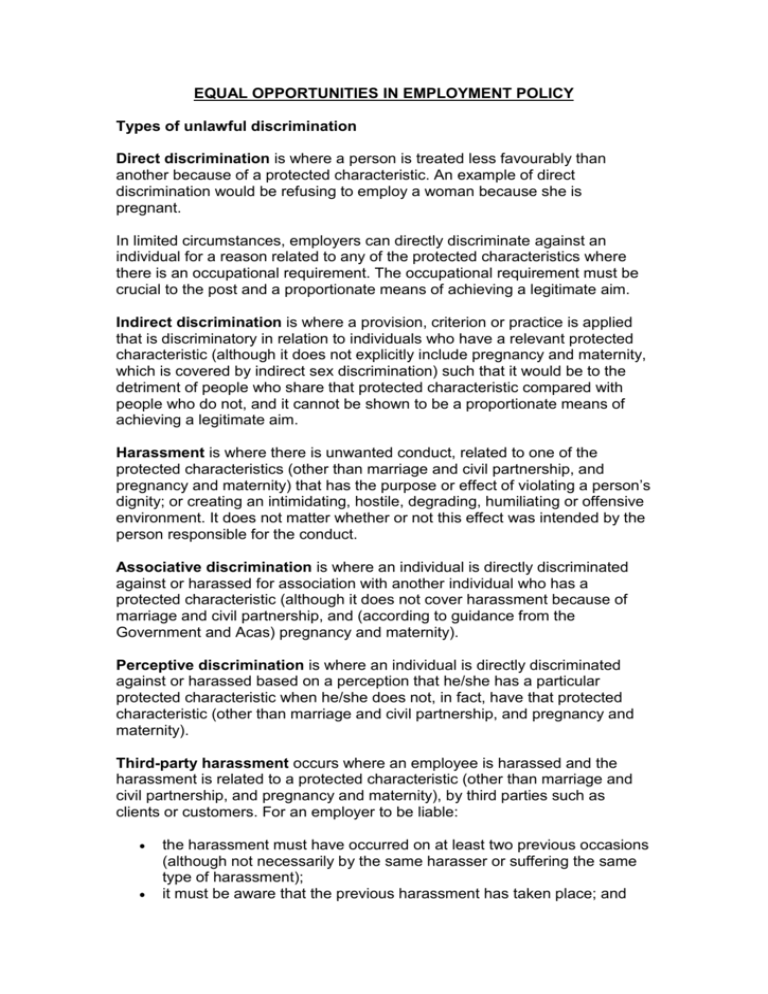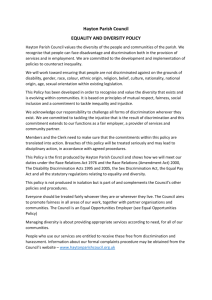
EQUAL OPPORTUNITIES IN EMPLOYMENT POLICY
Types of unlawful discrimination
Direct discrimination is where a person is treated less favourably than
another because of a protected characteristic. An example of direct
discrimination would be refusing to employ a woman because she is
pregnant.
In limited circumstances, employers can directly discriminate against an
individual for a reason related to any of the protected characteristics where
there is an occupational requirement. The occupational requirement must be
crucial to the post and a proportionate means of achieving a legitimate aim.
Indirect discrimination is where a provision, criterion or practice is applied
that is discriminatory in relation to individuals who have a relevant protected
characteristic (although it does not explicitly include pregnancy and maternity,
which is covered by indirect sex discrimination) such that it would be to the
detriment of people who share that protected characteristic compared with
people who do not, and it cannot be shown to be a proportionate means of
achieving a legitimate aim.
Harassment is where there is unwanted conduct, related to one of the
protected characteristics (other than marriage and civil partnership, and
pregnancy and maternity) that has the purpose or effect of violating a person’s
dignity; or creating an intimidating, hostile, degrading, humiliating or offensive
environment. It does not matter whether or not this effect was intended by the
person responsible for the conduct.
Associative discrimination is where an individual is directly discriminated
against or harassed for association with another individual who has a
protected characteristic (although it does not cover harassment because of
marriage and civil partnership, and (according to guidance from the
Government and Acas) pregnancy and maternity).
Perceptive discrimination is where an individual is directly discriminated
against or harassed based on a perception that he/she has a particular
protected characteristic when he/she does not, in fact, have that protected
characteristic (other than marriage and civil partnership, and pregnancy and
maternity).
Third-party harassment occurs where an employee is harassed and the
harassment is related to a protected characteristic (other than marriage and
civil partnership, and pregnancy and maternity), by third parties such as
clients or customers. For an employer to be liable:
the harassment must have occurred on at least two previous occasions
(although not necessarily by the same harasser or suffering the same
type of harassment);
it must be aware that the previous harassment has taken place; and
it must have failed to take reasonable steps to prevent harassment
from happening again.
Victimisation occurs where an employee is subjected to a detriment, such as
being denied a training opportunity or a promotion because he/she made or
supported a complaint or raised a grievance under the Equality Act 2010, or
because he/she is suspected of doing so. However, an employee is not
protected from victimisation if he/she acted maliciously or made or supported
an untrue complaint. There is no longer a need for a complainant to compare
his/her treatment with someone who has not made or supported a complaint
under the Equality Act 2010. For example, if a blind employee raises a
grievance that the employer is not complying with its duty to make reasonable
adjustments, and is then systematically excluded from all meetings, such
behaviour could amount to victimisation.
Failure to make reasonable adjustments is where a physical feature or a
provision, criterion or practice puts a disabled person at a substantial
disadvantage compared with someone who does not have that protected
characteristic and the employer has failed to make reasonable adjustments to
enable the disabled person to overcome the disadvantage.
1. Sex Discrimination
Unless the job is covered by a statutory exception we will not discriminate
directly, indirectly or by association on the grounds of sex, gender
assignment, sexual orientation, pregnancy, marital status or civil
partnership.
In the arrangements made for deciding who should be offered a job
In any terms of employment, including pay
By refusing or omitting to offer a person employment
In the way we afford access to opportunities for promotion, transfer
or training
In the manner in which employment is offered or in affording access
to any benefits, facilities or services
By victimising an individual for a complaint made in good faith about
sex, gender assignment, sexual orientation or pregnancy
discrimination or for giving evidence about such a complaint
In connection with redundancy or termination of employment
however caused or by treating an employee unfavourably in any
other way
2. Race Discrimination
Our equal opportunity policy aims to ensure that:
a. No job applicant or employee receives less favourable treatment
than another on racial grounds either directly, indirectly or by
association.
b. No applicant or employee is placed at a disadvantage by
requirements or conditions which have a disproportionately
adverse effect on his/her racial group and which cannot be
shown to be justifiable on other than racial grounds.
c. Where appropriate and where permissible under the Race
Relations Act employees of an under-represented racial group
are given training and encouragement to achieve equal
opportunity within the organisation.
We will not:
Discriminate in recruitment, promotion, transfer or training, nor in
the arrangements made for recruitment and in the ways of affording
access to opportunities for promotion, transfer or training
Discriminate on racial grounds in connection with dismissal,
redundancy or any other termination of employment or other
detriment to an employee
Discriminate on racial grounds in appraisals of employee
performance or in the operation of grievance disputes and
disciplinary procedures
Discriminate on racial grounds in affording terms of employment
and providing benefits, facilities and services for employees
Victimise individuals who have made allegations or complaints of
racial discrimination or provided information about such
discrimination
3. Disability Discrimination
In connection with dealings in relation to persons with a disability within the
meaning of the Equality Act 2010 and balancing the requirements of the
ISS Regulations 2010, we will:
Not discriminate against disabled people or those who have been
disabled, carers or by association
Make any reasonable adjustments of our employment
arrangements or premises which place disabled people at a
substantial disadvantage compared with non-disabled people
Not treat a disabled employee or disabled job applicant less
favourably for a reason relating to the disability than others to whom
that reason does not apply unless the reason is material to the
particular circumstances and substantial
Not knowingly help another to unlawfully discriminate against a
disabled employee
Not discriminate against a disabled person in the arrangements
made for determining who should be offered employment or by
refusing to offer, or deliberately not offering, employment
Not discriminate against a disabled person whom we employ in
terms of the employment we offer him/her; in the opportunities,
which we afford him/her for promotion, a transfer, training or
receiving any other benefit; by refusing to afford him/her or
deliberately not affording him/her any such opportunity; by
dismissing him/her or subjecting him/her to any other detriment
Not discriminate against an employee who becomes disabled or
has a disability that worsens, any reasonable adaptations including
changes to role will be considered to enabled continued
employment
4. Religion
Caterham School is designated as a Christian school under The Religious
Character of Schools Regulations 2003. Unless the job is covered by a
statutory exception we will not discriminate directly or indirectly or by
association on religious grounds.
In the arrangements made for deciding who should be offered a job
In any terms of employment, including pay
By refusing or omitting to offer a person employment
In the way we afford access to opportunities for promotion, transfer
or training
In the manner in which employment is offered or in affording access
to any benefits, facilities or services
By victimising an individual for a complaint made in good faith about
discrimination on religious grounds or for giving evidence about
such a complaint
In connection with redundancy or termination of employment
however caused or by treating an employee unfavourably in any
other way
5. Age Discrimination
In connection with any dealing in relation to age as described in the
Equality Act 2010, we will not discriminate on age either directly, indirectly
or by association:
In the arrangements made for deciding who should be offered a job
In any terms of employment, including pay
By refusing or omitting to offer a person employment
In the way we afford access to opportunities for promotion, transfer
or training
By victimising an individual for a complaint made in good faith about
discrimination on the grounds of age or for giving evidence about
such a complaint
In connection with redundancy or termination of employment
however caused.
To operate a common contractual retirement age for all staff of 65
(see separate Retirement Policy for details). This will be reviewed in
line with changes in legislation.
6. Roles and Responsibilities of the Headteacher, Staff and
Governors with regard to children
Set targets to challenge all children to achieve their potential
Deploy resources effectively and efficiently to ensure that all
children receive appropriate support
Celebrate diversity of all kinds as described above
Plan the curriculum and its delivery to take into account the ability,
gender, ethnicity, background and SEN of pupils
Prevent discrimination, harassment or bullying on the basis of
gender, ethnicity, sexual orientation, religion or age
Ensure that an inclusive approach is taken to children with
disabilities
Ensure that all staff understand what constitutes direct or indirect
discrimination
7. Harrassment
Caterham School is committed to a policy whereby all employees are
given the right to be treated with dignity and respect. Therefore
harassment is considered unacceptable at the School. Any member of
staff who is either harassed verbally or physically, by another member of
staff or a third party, must report it immediately to their Head of
Department, HR Manager or Deputy Head. The Headmaster will be
informed and the matter investigated. Please refer to the Disciplinary
Procedure for further information.
Last reviewed Nov 2012








